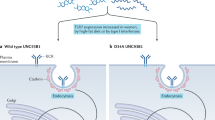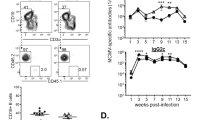Abstract
Using a range of different experimental approaches (and not just analyses of MyD88-deficient mice), we showed that, contrary to the prevailing view, a T-helper response is not sufficient for the generation of optimal T-dependent antibody responses, and that Toll-like-receptor (TLR) signalling in B cells is also required1. Similar results have since been obtained in human B cells2. Nemazee et al.3 now question our conclusions1.
Similar content being viewed by others
Main
We showed that the requirement for TLR signalling in antibody responses depends on the antibody isotype1: the IgM and IgG1 isotypes are largely, but not completely, TLR-dependent; IgG2 isotypes are entirely TLR-dependent; and IgE and IgA responses are TLR-independent. But in any event, our main discovery was that TLR signalling has to happen in B cells in order for the optimum T-cell-dependent antibody response to be generated. It was not, as claimed by Nemazee et al.3, simply that TLR-dependent B-cell responses depend on TLR signalling.
Figure 1 of Nemazee et al.3 shows responses obtained under suboptimal conditions, without essential comparisons and controls1: for example, their antibody responses would seem negligible if compared with the response induced in the presence of TLR ligands. The results do not therefore present a meaningful counterargument to our conclusions.
Nemazee et al. claim that TLR signalling is not essential for responses to “typical vaccination”, which very much depends on what is meant by ‘typical’. Most successful vaccines, such as attenuated pathogens, certainly do trigger TLR signalling, which is one of the reasons why they are successful. The subunit vaccines, on the other hand, generally do not work; the few that do, do so because they either activate TLRs or some TLR-equivalent component of the innate immune system.
References
Pasare, C. & Medzhitov, R. Nature 438, 364–368 (2005).
Ruprecht, C. R. & Lanzavecchia, A. Eur. J. Immunol. 36, 810–816 (2006).
Nemazee, D., Gavin, A., Hoebe, K. & Beutler, B. Nature 441, doi:10.1038/nature04875 (2006).
Author information
Authors and Affiliations
Corresponding author
Rights and permissions
About this article
Cite this article
Pasare, C., Medzhitov, R. Toll-like receptors and antibody responses (Reply). Nature 441, E4 (2006). https://doi.org/10.1038/nature04876
Published:
Issue Date:
DOI: https://doi.org/10.1038/nature04876
Comments
By submitting a comment you agree to abide by our Terms and Community Guidelines. If you find something abusive or that does not comply with our terms or guidelines please flag it as inappropriate.



